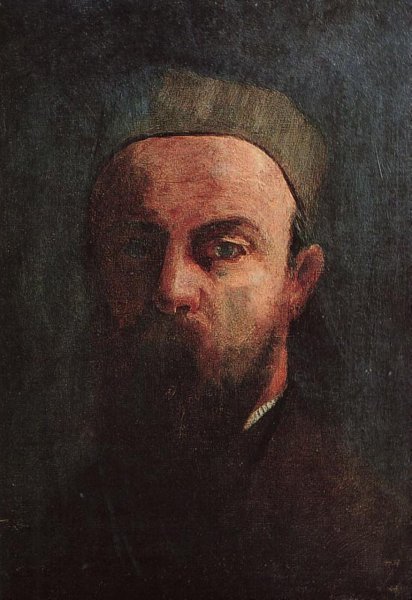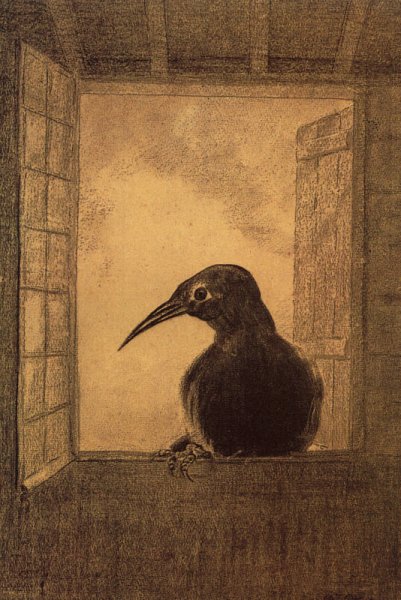Odilon Redon Biography In Details
Life

Bertrand-Jean Redon better known as Odilon Redon (April 20, 1840 - July 6, 1916) was a Symbolist painter and printmaker, born in Bordeaux, Aquitaine, France. Odilon was a nickname derived from his mother, Odile.
Redon started drawing as a young child, and at the age of 10 he was awarded a drawing prize at school. At age 15, he began formal study in drawing but on the insistence of his father he switched to architecture. His failure to pass the entrance exams at Paris' Ecole des Beaux-Arts ended any plans for a career as an architect, although he would later study there under Jean-Leon Gerome.
Back home in his native Bordeaux, he took up sculpture, and Rodolphe Bresdin instructed him in etching and lithography. However, his artistic career was interrupted in 1870 when he joined the army to serve in the Franco-Prussian War.
At the end of the war, he moved to Paris, working almost exclusively in charcoal and lithography. It would not be until 1878 that his work gained any recognition with Guardian Spirit of the Waters, and he published his first album of lithographs, titled Dans le Reve, in 1879. Still, Redon remained relatively unknown until the appearance in 1884 of a cult novel by Joris-Karl Huysmans titled, rebours (Against Nature). The story featured a decadent aristocrat who collected Redon's drawings.
In the 1890s, he began to use pastel and oils, which dominated his works for the rest of his life. In 1899, he exhibited with the Nabis at Durand-Ruel's. In 1903 he was awarded the Legion of Honor.[citation needed] His popularity increased when a catalogue of etchings and lithographs was published by Andre Mellerio in 1913 and that same year, he was given the largest single representation at the New York Armory Show. In 1923 Mellerio published: Odilon Redon: Peintre Dessinateur et Graveur.
In 2005 the Museum of Modern Art launched an exhibition entitled "Beyond The Visible", a comprehensive overview of Redon's work showcasing more than 100 paintings, drawings, prints and books from The Ian Woodner Family Collection. The exhibition ran from October 30, 2005 to January 23, 2006.
Analysis of his work

The mystery and the evocation of the drawings are described by Huysmans in the following passage:
"Those were the pictures bearing the signature: Odilon Redon. They held, between their gold-edged frames of unpolished pearwood, undreamed-of images: a Merovingian-type head, resting upon a cup; a bearded man, reminiscent both of a Buddhist priest and a public orator, touching an enormous cannon-ball with his finger; a spider with a human face lodged in the centre of its body. Then there were charcoal sketches which delved even deeper into the terrors of fever-ridden dreams. Here, on an enormous die, a melancholy eyelid winked; over there stretched dry and arid landscapes, calcinated plains, heaving and quaking ground, where volcanos erupted into rebellious clouds, under foul and murky skies; sometimes the subjects seemed to have been taken from the nightmarish dreams of science, and hark back to prehistoric times; monstrous flora bloomed on the rocks; everywhere, in among the erratic blocks and glacial mud, were figures whose simian appearance--heavy jawbone, protruding brows, receding forehead, and flattened skull top--recalled the ancestral head, the head of the first Quaternary Period, the head of man when he was still fructivorous and without speech, the contemporary of the mammoth, of the rhinoceros with septate nostrils, and of the giant bear. These drawings defied classification; unheeding, for the most part, of the limitations of painting, they ushered in a very special type of the fantastic, one born of sickness and delirium."
Redon also describes his work as ambiguous and undefinable:
"My drawings inspire, and are not to be defined. They place us, as does music, in the ambiguous realm of the undetermined."
Redon's work represent an exploration of his internal feelings and psyche. He himself wanted to "place the visible at the service of the invisible"; thus, although his work seems filled with strange beings and grotesque dichotomies, his aim was to represent pictorially the ghosts of his own mind. A telling source of Redon's inspiration and the forces behind his works can be found in his journal A Soi-meme (To Myself). His process was explained best by himself when he said:
"I have often, as an exercise and as a sustenance, painted before an object down to the smallest accidents of its visual appearance; but the day left me sad and with an unsatiated thirst. The next day I let the other source run, that of imagination, through the recollection of the forms and I was then reassured and appeased." (From wikipedia)




